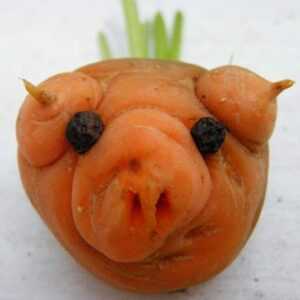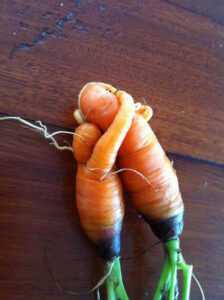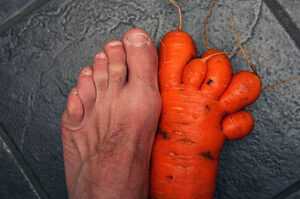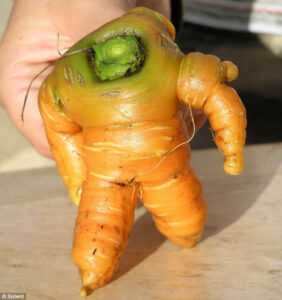Last month we took advantage of the rain’s tardiness and hosted several groups of children who were happy to take a tour of the field, try to guess what vegetable is hiding between the leaves and enjoy the experience of picking cherry tomatoes, cauliflower, kohlrabi and other veggies. And always, in every single tour, there was one charmingly youthful relentless question: “What about the carrots? Do we get to pick some carrots?”
Carrots are usually the highlight of our field tours. Something about yanking the pointed root out of the earth is akin to the discovery of a treasure. And extracting a carrot is not an easy task. It doesn’t hop out eagerly like the beet or turnip, so we must stake out the earth with a pitchfork (another exciting attraction of the life of a farmer!) and then proceed to move the root around while still underground, holding tight to the bundle of leaves adorning its head. Only then will the protracted fella come out in one piece. Now we can be impressed by it majestic features, and the children’s shining eyes prove that despite technology overtaking their cushioned daily lives, the magic of a single carrot can be something tremendously exciting.
So this week we’ll give the full honor due by dedicating this newsletter to His Majesty, The Carrot.
In a ponderous 1904 letter to his beloved wife Olga, Anton Checkhov writes, “You ask, ‘what is life’? That is the same as asking, ‘What is a carrot?’ A carrot is a carrot and we know nothing more.” Over a century later, we can no longer say that “a carrot is a carrot and we know nothing more.” Countless research studies have been conducted to examine this basic veggie, so common and beloved, generating a wealth of information on the carrot’s healthy components and its ability to maintain our health and to spur healing.
But Chekhov did articulate a hint of the mystery lying in the root. What meets the eye as we stroll by the carrot bed is only its bad-hair-day and the edge of its scalp. But when we tug it out of the soil – voila! Orange happiness retrieved from the dark underworld…
Winter is its season. The carrot does not appreciate warm weather, but adores the cold. It can even grow under a blanket of snow. Now that the weather has cooled off at last, the carrot has finally become a frequent guest in our field and your boxes. We seed several carrot beds every few weeks, and after several months pull out bed after bed of juicy orange corkscrew roots, week after week.
The carrot (Daucus carota) belongs to the Umbelliferae family, home to such vegetables and spices as celery, parsley, fennel, dill and cilantro. Various wild carrot species have grown in many areas in the world, specifically in five continents: the Mediterranean, South Asia, Africa, Australia and America. The origin of certain domesticated species is probably Afghanistan and Turkey. The Arabs introduced the carrot to Spain, where it spread to Europe. Its first domesticated varieties came in a range of colors: red, purple and yellow-green. Later, yellow and white carrots were developed. In the 18th century, the Dutch grew orange carrots, which are today’s most common variety. In Israel, the carrot has been raised from the beginning of the Jewish settlement. The Arabs used to grow dark purple carrots, which can still be found today to a small extent, mostly for aesthetic use.
The wild carrot is known in English as “Queen Anne’s lace,” a name which originated in a fairy tale about how the wild carrot’s flower got its distinctive look: a sort of white lace embroidery, with a dark red-purple dot at its center. Legend has it that Queen Anne (wife of King James I), who reigned as Denmark’s queen in the 16th and 17th centuries, was an expert at lace tatting. One day she pricked her finger in the process, and a drop of blood rolled onto the center to create this special flower. Although the tale only appeared in writing some 200 years after Anne’s death, it could be associated with the 17th century custom for ladies to smartly adorn their hats with wild carrot flowers.
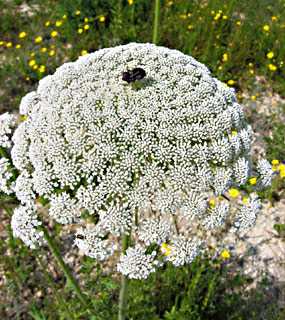
Queen Anne’s Lace
Carrots are usually biennial. At the end of their first year of growth, they develop leaves and a root. When the root is well-developed and the plant has received its necessary dose of cold weather, the next season leads to the development of a stem which grows rather tall. As the stem branches out, it produces peripheral branches which end in an inflorescence resembling an umbrella. The seeds remain in the dry fruit, one seed per fruit. They contain ethereal oil which provides their unique scent. When a carrot is grown for food, we are interested in its taproot, which is why it should be picked before reaching flowering and seeding – for by then the root is too old and becomes grainy.
The root develops in three stages, beginning right after sprouting when a long skewer-like root grows. At the second stage, the root thickens and becomes longer, gaining its orange color. At the third stage, the downward growth stops and the root only thickens.
The root consists of a central stele, the endodermis and the cortex. The endodermis is surrounded by tissue, which creates the inner cortex and the outer phloem. This tissue is rich in color substance and sugars. A carrot’s quality is determined by the thin texture of its central stele in comparison to the cortex tissues. In difficult growing conditions, or as the plant ages, the central stele becomes wood-like and the carrot is no longer fit for human consumption.
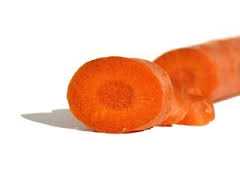
The carrot from in and out: the endodermis, the cortex and the phloem.
The carrots in your boxes were seeded three-and-a-half to four months ago. Never one to rush, the carrot sprouted slowly: first its two long ears, the cotyledons, peeked out of the earth. Afterwards the plant actually grew “real leaves,” the type we can identify as carrot greens, a true bunny gourmet treat.
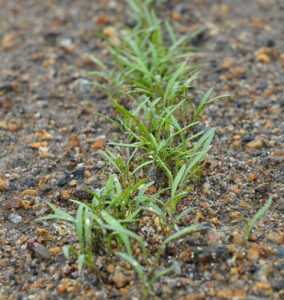
The Cotyledons, first sprouts
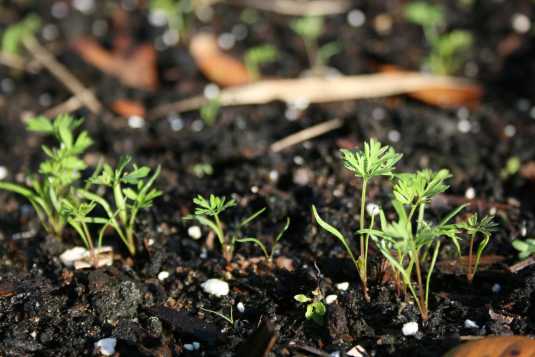
First real leaves
The carrot needs a lot of space to breathe and grow, in both length and depth and preferably from all four directions. But its seeds are tiny and hard to seed accurately and well-spaced. Thus, as soon as they begin to grow, we start thinning the plants and pluck out lots of tiny carrot sprouts to allow the remainder to grow nice, bountiful roots. Last week, as I was thinning out the carrot beds in my little Noga’s kindergarten vegetable plot, I found out that children enjoy being bunnies, too, as they happily consumed the tiny carrot plants we tugged out of the earth.

The orange of the carrot is known for its medicinal qualities: research highly acclaims it as a cancer and heart disease fighter. Carrots maintain healthy eyes, fortify the immune system, protect your skin, and generally boost human growth and vitality. Its healing powers come from the yellow-orange caratanoid pigment group: the alpha carotene, beta carotene and beta-cryptoxanthin.
Beta carotene, the most researched and popular pigment in the carrot, belongs to the carotenoid group, which becomes Vitamin A when consumed. For this reason they’re termed “pro-vitamin.” Vitamin A, aka “retinol” due to its benefits to the retina, plays a crucial role in healthy vision. A Vitamin A deficiency can impair the function of the photo-pigments in the retina and cornea, causing blindness or night blindness. Vitamin A promotes skin health and epithelial cell growth, and in pregnancy contributes richly to proper fetal development. Current research indicates that Vitamin A is critical to the process of learning and memory, probably by enriching the area of the brain responsible for memory function.
Vitamin A keeps the immune system working, whereas a deficiency can increase the risk of acquiring viral infections. In infectious diseases, a Vitamin A deficiency can aggravate the disease and increase the mortality risk. In Chinese medicine, carrots are known to strengthen the spleen and blood in anemia. Medical research supports this as well, recognizing that Vitamin A is beneficial in absorbing iron and relieving the symptoms of anemia.
Proper Vitamin A consumption has been linked to reducing the threat of many types of cancer, including eye, breast, large intestine, prostate, skin and liver.
Carrots also contain falcarinol, a natural pesticide which the carrot probably develops against harmful fungi by delaying the creation of material which encourages fungus growth. In a like manner, falcarinol hinders the creation of components which foster the growth of cancerous tumors, thus delaying their development.
Carrots are also rich in excellent “traditional” nutrition components: potassium and such B vitamins as folic acid, vitamins C, K, E and dietary fibers. In short, it is full of great stuff. Give the carrot a place of honor in your menu!
Beyond the orange beta carotene, carrots come in rainbow colors. How beautiful are these?
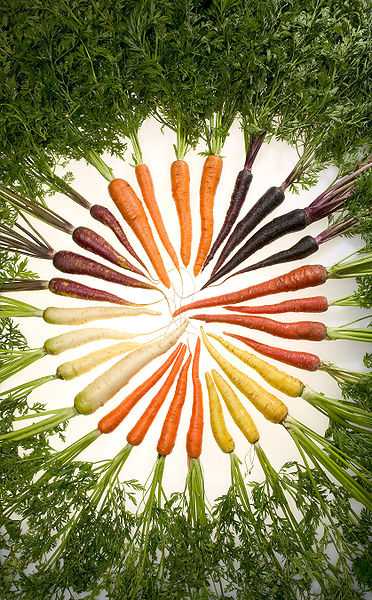
Overdosing on carrots may cause carotenemia – a temporary yellowing of the skin, caused by excessive consumption of beta carotene from fresh carrots. This is not dangerous, only a little strange-looking, and it disappears several weeks after going cold turkey on beta carotene.
Carrot Tips
– If you receive carrots in a bunch, complete with greens, the best way to store them is by removing the greens. Otherwise they will draw water from the root and cause it to shrivel.
– Carrots should be stored in the coldest place in the refrigerator, in a plastic bag or in the vegetable drawer.
– The carrot is best unpeeled. You can lightly scrape the peeling, or not at all. The peeling is tasty and nutritious.
– Like the tomato, a cooked carrot is more nutritious and healthier than a raw carrot. The level of vitamin A rises as the cooking – and even a light scraping – breaks down the cell walls. It is best to cook carrots in a small amount of water, so the vitamins are not diffused in the cooking liquid.
Check out our recipe section for nice diverse ideas for carrot cuisine.
* Adding a small amount of oil to the cooking liquid will increase the absorption of antioxidants.
– It is recommended to combine carrots with foods containing vitamin E, such as peanuts, pumpkin, leafy vegetables and whole grains.
When you purchase carrots in the supermarket, they are already meticulously sorted out with only the right sizes and shape surviving the selection and placed on the shelves. (The rest usually become “baby” carrots…) But in the field, the carrots grow in various shapes, revealing the playfulness and grace of the charming carrot that loves to dance, hug, hang out and make funny faces. Here are some vivid examples:
Wishing you a great orange week – in health, happiness and good living!
Alon, Bat Ami, Dror, Orin, Yochai and the entire Chubeza team
____________________________________
WHAT’S IN THIS WEEK’S BOXES?
Monday: Swiss chard/kale, kohlrabi/turnips, sweet potatoes, cucumbers, tomatoes, daikon/baby radishes, carrots, parsley/dill, lettuce/arugula/mizuna, beets/fennel. Small boxes only: scallions/onions
Large box, in addition: Celery/celeriac, New Zealand spinach/totsoi, broccoli/ Jerusalem artichokes/Lubia Thai yard-long beans, cabbage/eggplant/green bell peppers.
FRUIT BOXES: Bananas, red apples, pomelit, oranges, clementinas.
Wednesday: Swiss chard/New Zealand spinach, sweet potatoes, scallions/fresh onions, cucumbers, tomatoes, broccoli/eggplant/green bell peppers/cabbage, carrots, parsley/dill, lettuce/arugula/mizuna, daikon/baby radishes, kohlrabi/turnips.
Large box, in addition: Kale/totsoi, beets/fennel, Lubia Thai yard-long beans/Jerusalem artichokes/peas.
FRUIT BOXES: Red apples, bananas/avocados, oranges, pomelit, clementinas.


